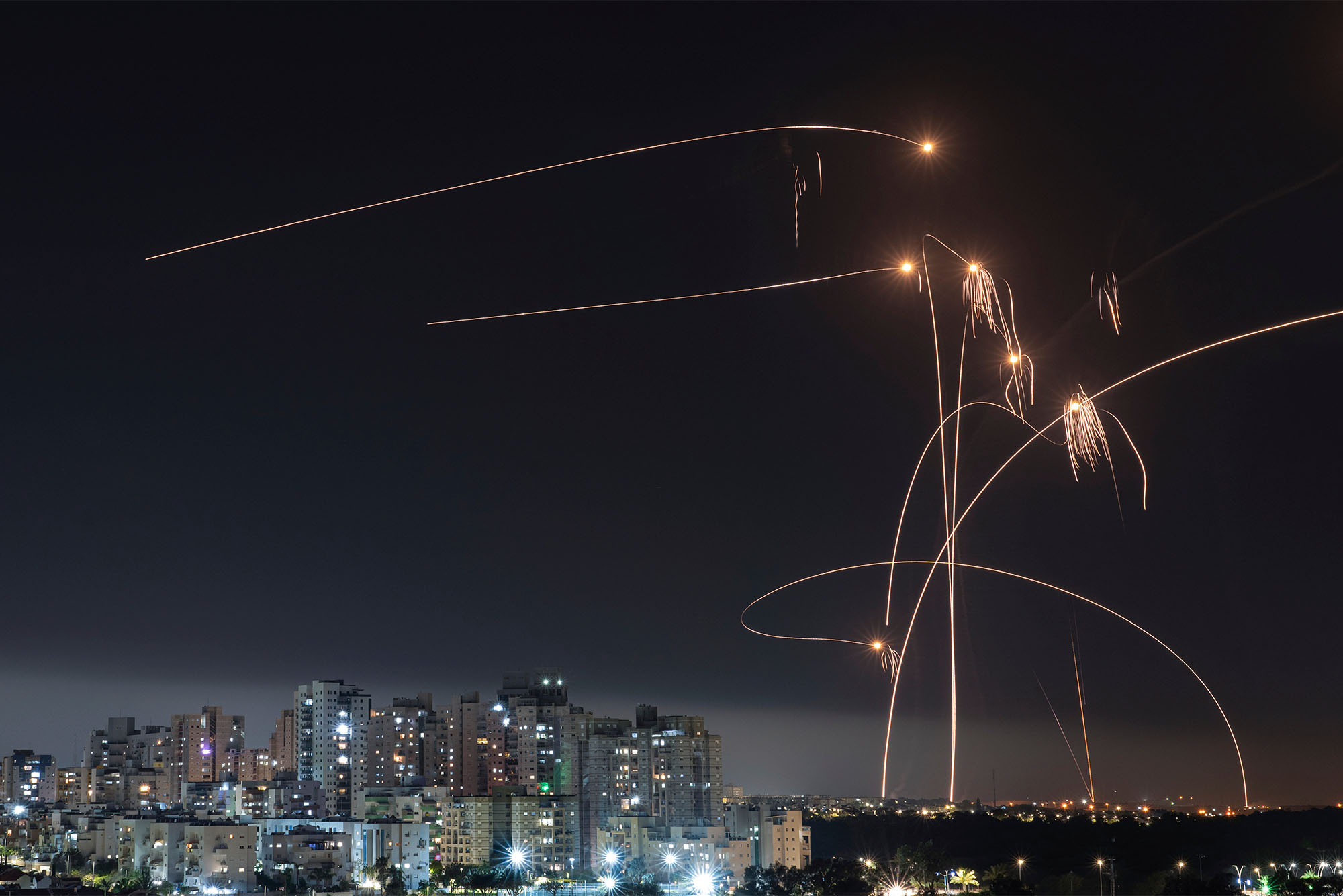Missile Defense Won’t Save Us from Growing Nuclear Arsenals
“You can’t build the impenetrable shield,” says BU military tech expert Sanne Verschuren

Israel’s Iron Dome missile defense system fires interceptors at rockets launched from the Gaza Strip, but BU international security researcher Sanne Verschuren questions the system’s effectiveness. Photo by AP Photo/Tsafrir Abayov
Missile Defense Won’t Save Us from Growing Nuclear Arsenals
“You can’t build the impenetrable shield,” says BU military tech expert Sanne Verschuren
As a child in 1990s Belgium, Sanne Verschuren watched news of the Balkan war’s horrific carnage. “Why are these people fighting?” she recalls asking her grandfather. “Why can’t they just make peace?” Later, her law school thesis at Ghent University focused on the regulation of new military technologies—such as drones—under international law.
“That puzzlement of why people fight, and at such massive scales,” drives her research into weapons of war, from nuclear weapons to antimissile defense, says Verschuren, an assistant professor of international security at the Boston University Frederick S. Pardee School of Global Studies. “Military technology, to me, sits at the crossroads of a lot of different things. It’s a legal question, a political question, a social question, a budgetary question—it’s a question of imagination.”

In recent studies, she’s explored how weapons shape international security policy and national security decision-making, and particularly what motivates states to throw money at some weapon systems over others. One conclusion she’s come to is that averting nuclear Armageddon with large-scale missile defenses is a pipe dream, dating back to President Ronald Reagan’s hope of deploying a space-based, antimissile “Star Wars” shield to take down Soviet long-range intercontinental ballistic missiles, or ICBMs. She’s also questioned more earthbound systems, particularly the continuing technical difficulties around the Ground-Based Midcourse Defense (GMD) System, which is designed to take down North Korean ICBMs, and the lack of data around battlefield effectiveness of shorter-range defensive systems, like those used in Israel’s Iron Dome mobile air defense system or the Patriot system included in Western aid to Ukraine.
Verschuren—who is finalizing her first book, about how and why states develop weapon technologies—cautions that when it comes to literal bang for the buck, the numbers are on the side of an attacker. “The United States government has spent at least $350 billion on missile defense over the last seven decades,” she says. “It’s a ton of money for systems that still face significant technical challenges. These systems also have important implications for international stability, particularly the relationships between nuclear-armed states.” She discussed the wisdom of those investments and the fragile state of that nuclear stability with The Brink.
Q&A
With Sanne Verschuren
The Brink: How does your research support—or not—defense systems? When Israel was attacked by Iran, Iron Dome supposedly showed that missile defense worked.
Verschuren: While Iron Dome and [Israel’s antiballistic missile] Arrow 3 appear to have intercepted some of the 300 drones, cruise missiles, and ballistic missiles that Iran fired toward Israel, a significant role was played by the American, British, French, and Jordanian air forces. It was also the first time that the Aegis BMD, a ship-based missile defense system, was used in action.
Even short-range missile defense systems have a mixed record. Patriot [the US Army’s primary defensive missile system] was engaged for the first time in the 1991 Gulf War. There was a low rate of interception of Iraqi missiles—maybe even just one. While the technology has come a long way since the early 1990s, it is important to continue to examine the success rate of these systems in combat. In Ukraine, we can find videos on X [formerly Twitter] of successful engagements, but we also see videos of things going wrong. Likewise, we should be careful about our interpretation of the thwarting of the Iran attack. In the end, we were talking about relatively low-flying, unsophisticated drones and cruise missiles—with advanced warning. This was not the hardest stuff in the world to intercept.
While some commentators use Ukraine and Israel to claim success of the overall missile defense mission, short-range missile defense systems, such as Patriot, and air defense systems, like Iron Dome, have nothing to do with high-end stuff.
The Brink: The interception of ICBMs?
Verschuren: Yeah. Interception of those missiles takes place outside of [Earth’s] atmosphere. ICBMs have countermeasures—things that an adversary puts in place to ensure that its missiles can penetrate defenses. This can range from increasing the size of the attack by adding multiple warheads to a missile to the use of decoys. All of this makes it harder for the interceptor to identify and take down the nuclear warhead. The Russian and Chinese ICBMs have such sophisticated countermeasures that the US system cannot deal with those things.
Another problem is what I call “the numbers game.” Defenses are much more expensive than offensive systems. All the drones and cruise missiles that Iran sent must not have cost that much money. The means of interception, whether it was the aircraft or air and missile defense systems, is reported to have cost more than $1 billion. Interceptors cost a lot of money, compared to what is being shot at them.
Another dimension of the numbers game is that countries have defensive systems in far fewer numbers. You’re going to have to use multiple interceptors to take down one ICBM—you really do not want to have a nuclear weapon explode on your territory.
Member nations of the world’s nuclear club are growing their arsenals as arms control withers, Verschuren says. Chart courtesy of the Federation of American Scientists
The Brink: Can fighter jets be the backbone of workable defense, if they did so well against Iran?
No. You still have the cost equation that’s really off. Offensive is just a lot cheaper, and you have more of it than you ever have of defensive. The balance will always be out of whack.
The other problem is strategic implications. Even if the US missile defense systems’ stated purpose is to deal with threats from so-called rogue states like North Korea and Iran, the Russians and Chinese have chosen not to accept that. Considering [US missile defense] a threat to their nuclear deterrent, they have adopted a wide range of measures to counter these systems—increasing their nuclear arsenals or developing all sorts of exotic systems like hypersonic delivery vehicles.
The US develops missile defense systems; the Russians and Chinese go, ah, then we have to build things that are evading that. We find ourselves in a dangerous arms race right now.
Given the technical limitations faced by many of these systems, the unfavorable numbers on the part of the defender, and the negative strategic consequences, one can reach only one conclusion: You can’t build the impenetrable shield.
The Brink: So, to advance nonproliferation, what would be the one policy your research advocates?
It is crucial for the Biden administration to keep engaging their Russian and Chinese counterparts on strategic issues—whether through mere conversation, the implementation of confidence-building measures, or actual concessions. For example, the United States should reflect upon the role that missile defenses have played in that strategic relationship with Russia and China.
The Clinton administration used the argument that missile defense could dissuade a country that’s thinking about building nuclear weapons, but I don’t think that makes any sense. I do think we’re in a world that is a lot more dangerous, because of increased tensions between the world’s major powers, their ongoing nuclear modernization, and their experimentation with risky technologies, like strategic missile defenses. A lot of arms control agreements that we had in the first place actually came about in periods when the world was on the brink. My recommendation, and I think the Biden administration is doing that, is keep talking to the Russian and Chinese counterparts on these strategic issues.
I do think we’re in a world that is a lot more dangerous, because of increased tensions between the world’s major powers, their ongoing nuclear modernization, and their experimentation with risky technologies, like strategic missile defenses.
The Brink: Might the stability of membership in the world’s nuclear club be poised to end, given Vladimir Putin’s threats of putting a nuke in space, North Korea’s tests, and that we pulled out of the Iran nuclear deal?
Nuclear-armed countries around the world are all modernizing their nuclear weapons arsenals. They are adding nuclear warheads to their operational forces. They are developing new delivery vehicles. The arms control framework—that was developed during the Cold War and early post-Cold War period to put some guardrails on the nuclear aspirations of the world’s nuclear weapon states—has fallen apart. Both the United States and Russia have abrogated various treaties. And between the war in Ukraine, the conflict in the Middle East, and the tensions in East Asia, the world is a much more insecure place. This might incentivize countries to beef up their national security, potentially even with nuclear weapons. It might also make it harder for countries to prevent unwanted nuclear breakouts. Past research, for example, has shown that sanctions are most effective when implemented and enforced by a large number of countries. Likewise, the nuclear threats that have been made by Putin throughout the war in Ukraine are very worrisome too. It is not out of the realm of possibilities that we might find ourselves in a situation where the nuclear taboo—a strong norm within the international community that outlaws the use of nuclear weapons—might be broken.
The Brink: What is the goal of your research?
I am contributing to scholarly discussions about the origins of military technology, the evolution of strategic thinking among nuclear-armed countries, and the relationship between conventional and nuclear weapons. These are the three areas of my expertise. In my classes at BU, I’m [also] encouraging students to think about these questions. The public is largely absent from these debates, even though these strategic questions have huge implications for them. We’re all living in a world with nuclear weapons and with a myriad of missile defense systems.
Finally, I’m trying to make policymakers understand the technical limitations of [defensive] systems, and to take seriously those limitations when they make calculations about strategic behavior. The other thing I am advocating for is to have different communities talk to each other on missile defense. I have found that arms control communities are typically reluctant to talk about missile defense. However, missile defense will be an integral part of any arms control agreement moving forward. The Chinese and Russians have invested in [offensive] systems designed to evade US missile defense.
This interview has been edited for brevity and clarity.

Comments & Discussion
Boston University moderates comments to facilitate an informed, substantive, civil conversation. Abusive, profane, self-promotional, misleading, incoherent or off-topic comments will be rejected. Moderators are staffed during regular business hours (EST) and can only accept comments written in English. Statistics or facts must include a citation or a link to the citation.